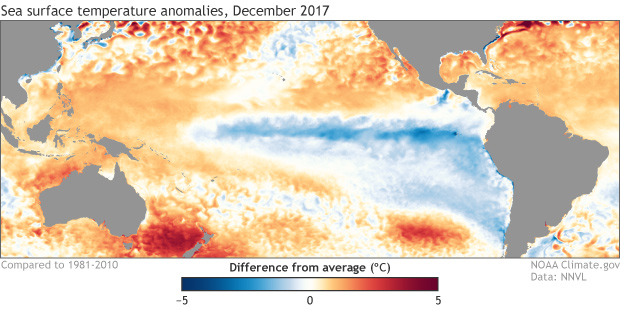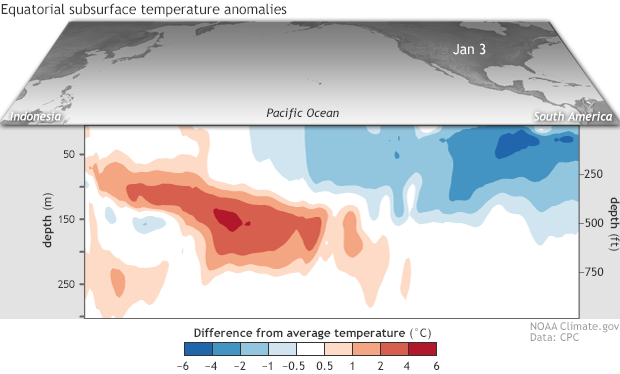Now that we are smack dab in the middle of winter in the Northern Hemisphere, the time of year when ENSO tends to have its more reliable impacts in the United States, it’s go-time for paying attention to what’s going on in the Pacific. And the latest CPC/IRI ENSO forecast says…[drum roll please]…La Niña is here to stay for this winter with a 85-95% probability before transitioning to ENSO-Neutral conditions during the spring.
Sidenote: Also, who is this person writing this post who is definitely not Emily? I’m Tom and I’m filling in for Emily this month (see footnote for Emily’s whereabouts). And just like a normal substitute teacher, don’t be surprised if I end this article early and just make you watch a video. So buckle up!

December 2017 sea surface temperature departure from the 1981-2010 average. Graphic by climate.gov; data from NOAA’s Environmental Visualization Lab.
Settle down class, time to go over what’s going on in the Pacific
We are certainly in the midst of a La Niña event as sea surface temperatures across the central/equatorial Pacific continue to remain colder than average. In fact, in December the SSTs in the Niño3.4 region—the box in the Pacific Ocean where we look for La Niña or El Niño conditions—were around 1°C cooler than average for the second consecutive month. Three-month average anomalies of 1°C mark the cutoff between weak and moderate ENSO events, putting this La Niña on the cusp of a moderate event, should the anomalies last one more month.
Of course, we can’t forget that La Niña is a coupled ocean-atmospheric system. So what is the atmosphere doing?
For the month of December, the thunderstorm activity across the equatorial Pacific looked pretty La Niña-like with reduced precipitation near the date-line and farther east while enhanced precipitation fell across the broader Maritime continent in the western Pacific Ocean. Backing this up, the Equatorial Southern Oscillation Index, which monitors areas closely related to ENSO along the equator, measured 0.9 for December. Positive values reflect lower than average pressure in the western Pacific and higher than average pressure in the central/eastern Pacific Ocean (2).

Departure from average of the surface and subsurface tropical Pacific
sea temperature averaged over 5-day periods centered on January 3, 2018.
The vertical axis is depth below the surface (meters) and the
horizontal axis is longitude, from the western to eastern tropical
Pacific. This cross-section is right along the equator.
...MUCH MORE